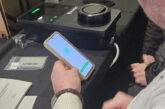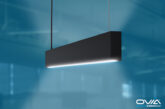
Amit Ravat, MD of Lithe Audio which produces fire and acoustic hoods for ceiling speakers, discusses some of the key criteria installers need to be aware of to ensure installed audio systems are fire safe.
Meeting UK building regulations is a fundamental aspect of any ceiling speaker installation, as these regulations ensure that audio systems are safe, reliable, and efficient. This includes ensuring fire resistance, energy efficiency, structural integrity, and acoustic performance.
By adhering to these standards, installations not only provide quality sound but also contribute to overall building safety and sustainability.
Unparalleled protection
Fire and acoustic hoods play a crucial role in ensuring the safety and effectiveness of ceiling speaker installations. These hoods provide a protective barrier that helps maintain the fire resistance of ceilings, which is essential in adhering to UK building regulations.
By containing potential fire hazards within the speaker enclosure, they limit the spread of flames, offering critical time for evacuation and emergency response.
Additionally, acoustic hoods enhance sound quality by minimising sound leakage and improving acoustics within a room. This results in a more immersive audio experience without compromising safety.
Brands like Lithe Audio set the standard for safety and performance in-ceiling speaker installations by offering fire and acoustic hoods.
These essential components are meticulously designed to meet the stringent UK building and electrical regulations, providing unparalleled protection and peace of mind. They’re designed with compliance in mind, incorporating features that preserve fire resistance for up to 90 minutes and are compliant with Parts B, L, C, and E regulations.
Comprehensive instructions
With products like Lithe Audio ceiling speakers, electricians can now install ceiling speakers as they would install a downlight. Power is added from any permanent live feed through the included power driver also designed to be used in ceilings.
They come with detailed installation guidelines and video guides, ensuring that electricians can achieve flawless setups, and providing step-by-step guidance to guarantee that the speakers are fitted correctly and safely.
The guidelines cover all aspects of installation, from wiring and positioning to securing the fire and acoustic hoods. By following these instructions, users can ensure that the installations meet necessary electrical compliance and safety standards.
This thorough approach not only facilitates a smooth installation but also optimises the audio system’s performance, ensuring clear and immersive sound quality.
For the many other different types of audio installation within a home, our advice to electricians would be:
1. Familiarise yourself with relevant regulations and standards
BS 7671 compliance
Ensure all electrical work complies with the latest edition of BS 7671 (IET Wiring Regulations), which outlines the standards for electrical installations in the UK. This includes requirements for safe earthing, protective devices, and cable sizing.
Audio-specific standards
Be aware of standards specific to audio installations, such as those set by the Audio Engineering Society (AES) and British Standards (BS). These standards offer guidance on signal integrity, grounding, and shielding techniques to prevent interference.
2. Conduct a comprehensive site survey
Assess existing electrical infrastructure
Inspect the site’s existing electrical infrastructure to determine if it meets the requirements for the new audio installation. Check for issues like outdated wiring, insufficient circuit capacity, or improper grounding.
Identify potential hazards
Look for any potential electrical hazards, such as exposed wiring, faulty outlets, or moisture-prone areas. Address these issues before proceeding with the installation.
3. Design for electrical and audio performance
Dedicated circuits for audio equipment
Use dedicated circuits for audio equipment to prevent electrical noise and interference from other devices. Ensure these circuits are appropriately rated and installed with residual current devices (RCDs) to provide additional protection.
Proper earthing and grounding
Implement a robust grounding scheme to prevent electrical shocks and minimise hum and noise. Ensure all audio equipment is connected to a common ground, and avoid ground loops by using star grounding techniques.
Correct cable selection
Choose cables that meet both the electrical and audio requirements of the installation. Use high-quality, shielded cables to prevent interference, and ensure cables are rated for the current they will carry.
4. Implement safe and effective cable management
Secure cable routing
Route cables away from high-power electrical lines to avoid interference. Use trunking or conduit to protect cables from physical damage and ensure compliance with fire safety regulations.
Minimise cable lengths
Keep cable lengths as short as possible to reduce resistance and minimise signal loss. Proper cable management also helps prevent tripping hazards and accidental disconnections.
5. Install surge protection and power conditioning
Use surge protectors
Install surge protection devices to safeguard sensitive audio equipment from voltage spikes and surges. Consider whole-house surge protection for comprehensive safety.
Power conditioners for clean power
Employ power conditioners to provide stable and clean power to audio equipment, reducing the risk of damage from electrical noise and ensuring consistent performance.
6. Use quality equipment and materials
Certified components
Use electrical components and audio equipment that have been tested and certified by recognised standards bodies such as BSI (British Standards Institution) or CE marking.
Choose peace of mind
Opting for Lithe Audio ceiling speakers provides peace of mind. Each speaker is designed with meticulous attention to compliance with UK building regulations, ensuring safety and reliability in any installation.
The incorporation of fire and acoustic hoods further enhances safety by preventing the spread of fire and optimising sound quality. With multiple products to suit different environments and robust quality certifications, these speakers are built to withstand diverse environmental conditions, making them a durable choice for any space.
Get more details about Lithe Audio’s range of ceiling speakers here
Find more industry feature articles here














